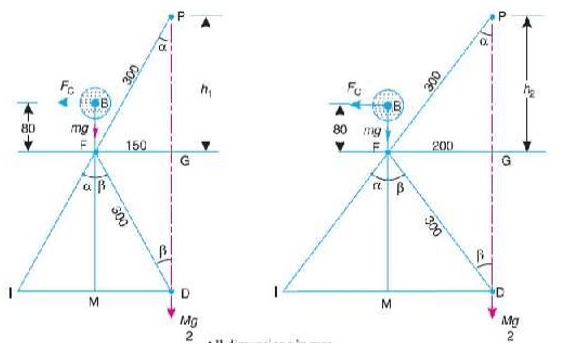This set of Farm Machinery Multiple Choice Questions & Answers (MCQs) focuses on “Principles of Governor”.
1. The average speed of engine connected to governor is 1500 rpm. If the fluctuation in speed is +-100 rpm, then % governor regulation is ______
a) 13.33%
b) 14.56%
c) 19.01%
d) 21.23%
View Answer
Explanation: Nmin = 1500 – 100 = 1400 rpm
Nmax = 1500+100 = 1600 rpm
Governor regulation = \(\frac{1600-1400}{1500}=\frac{200}{1500}\) = 13.33%
2. Varying the governor setting in an IC engine
a) Does not vary the maximum power developed in the engine
b) Varies the maximum torque developed by the engine
c) Does not vary the governed range of speed in which engine runs
d) Remains constant
View Answer
Explanation: Governor is a mechanical device which controls the speed of the engine by supplying fuel on varying load condition. When there is less load on engine speed of rotation of spindle increases and more centrifugal force acts on flyballs throwing them outwards thus sleeve moves upward and fuel supply is decreased.
3. At an engine throttle position of 75% the high idle speed of engine is shifted by 200 rpm towards maximum torque position. If the engine is maintaining a uniform speed of 2475 rps at given load, governor regulation is _____
a) 9.76%
b) 7.77%
c) 12.67%
d) 1.89%
View Answer
Explanation: At given load
Nmin = 2475 rpm
Above maximum torque position
Nmax = 2475 + 200 = 2675 rpm
Governor regulation = \(\frac{[2(275-2475)]}{2675+2475}\) = 7.77%
4. The high idle speed of engine is 2240 rpm. The peak torque of 180 Nm occurs, at 1450 engine rpm. If the lugging ability is 28 Nm. The engine power in KW at governor’s maximum position will be _________ (Governor regulation = 11.5%)
a) 42.5 KW
b) 51.49 KW
c) 23.12 KW
d) 31.3 KW
View Answer
Explanation: Nmax = 2240 rpm
At 180 Nm = N = 1450 rpm
Lugging = 28 Nm
So, at 180 – 28 = 152 Nm, let speed be Nmin
GR = 11.5% = 0.115%
0.115 = \(\frac{[2(2240-Nmin)]}{2240+Nmin} \)
Nmin = 1966.40 rpm
P = 2πNτ = 2 * π * 1966.40 * 152 = 31.3 KW
5. Which governor does not achieve ISOCHRONOUS behaviour?
a) Hartnell
b) Spring Controlled
c) Porter and Proell
d) Watt
View Answer
Explanation: In Porter and Proell governor, we never achieve ISOCHRONOUS behaviour because we can’t neglect friction between sleeve and spindle.
6. Which governor is known as sensitive governor?
a) Which keep speed fluctuation as small as possible
b) Which keep speed fluctuation as large as possible
c) Which doubles the speed fluctuation
d) Which remains constant
View Answer
Explanation: While considering performance of engine during sensitiveness analysis of governor, requirement is to keep speed fluctuation as small as possible and governor which does this is called sensitive governor.
7. A Proell governor has equal arms of length 300 mm. The upper and lower ends of the arms are pivoted on the axis of the governor. The extension arms of the lower links are each 80 mm long and parallel to the axis when the radii of rotation of the balls are 150 mm and 200 mm. The mass of each ball is 10 kg and the mass of the central load is 100 kg. Determine the range of speed of the governor.
a) 20 rpm
b) 30 rpm
c) 10 rpm
d) 25 rpm
View Answer
Explanation:

sin α = sin β = 150 / 300 = 0.5 or α = β = 30°
and, MD = FG = 150 mm = 0.15 m
FM = FD cos β = 300 cos 30° = 260 mm = 0.26 m
IM = FM tan α = 0.26 tan 30° = 0.15 m
BM = BF + FM = 80 + 260 = 340 mm = 0.34 m
ID = IM + MD = 0.15 + 0.15 = 0.3 m
FC – m (ω 1)2 * r1 – 10 \([\frac{2πN}{60}]\)2 – 0.0165 (N1)2
N1 = 170 rpm
h = PG = (PF)2 – (FG)2 = (300)2 – (200)2 = 224 mm = 0.224 m
FM = GD = PG = 224 mm = 0.224 m
BM = BF + FM = 80 + 224 = 304 mm = 0.304 m
Range of speed = N2-N1 = 10 RPM
8. Who theoretically analysed James Watt’s design as a mathematical energy balance purpose?
a) Isaac Newton
b) Willard Gibbs
c) Matthew Boulton
d) James Clark Maxwell
View Answer
Explanation: Building on Watt’s design was American engineer Willard Gibbs who in 1872 theoretically analysed Watt’s conical pendulum governor from a mathematical energy balance perspective. During his Graduate school years at Yale University, Gibbs observed that the operation of the device in practice was beset with the disadvantages of sluggishness and a tendency to over-correct for the changes in speed it was supposed to control.
Sanfoundry Global Education & Learning Series – Farm Machinery.
To practice all areas of Farm Machinery, here is complete set of 1000+ Multiple Choice Questions and Answers.
If you find a mistake in question / option / answer, kindly take a screenshot and email to [email protected]
- Check Farm Machinery Books
- Practice Agricultural Engineering MCQs
- Check Agricultural Engineering Books
- Apply for Agricultural Engineering Internship
